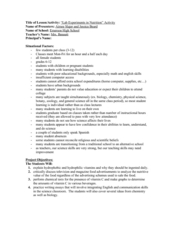Curated OER
Community Connections
Eighth graders with a number of disabilities visit people and places in their community while using digital cameras to record their visits. They take digital pictures which they include in books, posters, and other publications which...
Curated OER
Anatomy Grade Level: First Grade - FIVE SENSES
First graders name the five senses, identify major body structures and organs and describe their basic functions. In this anatomy instructional activity, 1st graders learn about the basic structures and functions of the human body and...
Curated OER
Cool Line
Students learn foot and arm patterns, then sequence those patterns into a line dance.
Curated OER
Throw and Catch Tennis
Students practicewith a racket, to learn strategies for moving the ball around the court and the importance of placing the ball in different spots .
Curated OER
Look Ma, No Hands!
Young scholars in Advanced Keyboarding Applications class practice using Voice Recognition software to compose and "voice" four written assignments. They explain why this technology is useful to those with physical disabilities or those...
Curated OER
Brainiac Tag
Pupils participate in a special game of tag while reinforcing the math skills they have learned.
Curated OER
Why Garden in New York State Schools?
A lovely presentation in which slide after slide outlines the many educational, physical, emotional, and social benefits of gardening in schools. This presentation is meant to be shown to parents, and would be a terrific choice to...
Curated OER
Experience the Challenge of Being Pete Gray
Students view films, photographs and engage in an empathy-building exercise to become familiar with Pete Gray, the first one-armed major league player. They read an interview and write an essay about Gray's career.
Curated OER
Phoebe The Spy
Fourth graders read the book, Phoebe The Spy, by Judith Berry Griffin. They complete comprehension activities, make predictions about what happen next, and create a PowerPoint book report for the story.
Texas Center for Learning Disabilities
Second-Grade Comprehension-Based Intervention
Help your youngsters find meaning in the text they read with this series of five intervention lessons. Offering explicit, step-by-step instructions for walking children through shared readings of leveled books, these...
Texas Center for Learning Disabilities
Fifth-Grade Text-Based Intervention
Look no further—here's a resource packed with focused intervention materials for special education teachers. A unique unit plan provides 10 days of structured text-based intervention strategies for fifth-grade learners. Each 30-minute...
Meadows Center for Preventing Educational Risk, University of Texas at Austin
Sight Word Fluency Lists 31 to 45
Practice makes perfect. Scholars get a lot of practice with sight word recognition as they continue to read words from each list until they master all words. Lists offer both new and review words.
Meadows Center for Preventing Educational Risk, University of Texas at Austin
Sight Word Fluency Lists 46 to 60
Reading takes place one word at a time. Increase scholar word recognition fluency and create better readers with sight word fluency lists. Readers continue to practice each list until they prove mastery.
Meadows Center for Preventing Educational Risk, University of Texas at Austin
Sight Word Fluency Lists 61 to 70
Every word matters. Increase reading fluency with word recognition practice. Scholars continue to practice reading words in each list until they demonstrate mastery. Readers practice both new and review word lists.
Meadows Center for Preventing Educational Risk, University of Texas at Austin
Sight Word Fluency Lists 16 to 30
Record keeping and data is essential to tracking scholar growth. Educators record pupil mastery of sight word recognition on nine pre-made sheets. Teachers and parents easily view data, progress, and word mastery.
Texas Center for Learning Disabilities
Teacher Templates
Letter by letter, sound by sound, monitor the growth of your emergent readers with these assessment templates. Adaptable to the needs of individual students, these one-on-one assessments focus on children's ability to identify letters...
Curated OER
Dance: Water Dancing
Examine the way water moves, drips, and splashes with an expressive dance. Learners discuss the ways in which water moves, then create dance sequences that show or describe water. There are several suggestions to adapt this instructional...
Curated OER
Solar System
Students research the nine planets on the internet using the provided links. They also search for pictures of each of the nine planets and use these pictures to create a PowerPoint slideshow. Finally, they prsent their slideshow report...
Curated OER
Butterflies Fly!
Chopin was a lovely composer who played the piano masterfully. Third graders are introduced to Chopin, his piano sounds, triple meter, music patterns, movement, and the waltz. They listen to his music while hearing the story Butterflies...
Curated OER
Words of Deep Meaning
Students create their own poems to express a deep feeling or transformative experience, then write imaginary letters to people in the article, responding to their poetry and sharing their own creative process.
Curated OER
First-Aid Newspaper
Eighth graders research, write, edit and publish a class newspaper focusing on topics related to first aid. They research how to care for injuries and write informative articles for the paper. Students compile the articles to produce a...
Curated OER
Sneetches: Diversity of Learners
For Learners wanting to practice verbal/linguistic intelligence, any Dr. Seuss book is an excellent text for examining rhyming words. They explore words that rhyme with bully, mean, snooty, nasty, tease, harass, hurt.
Curated OER
Lab Experiments in Nutrition Activity
Which vitamins should be ingested daily for maximum nutrition? Learners with ispecial needs or those who are pregnant focused on television and magazines advertisements that are used to sell food products. They conduct experiments and...
Curated OER
Rockin' Round New York State
Students discuss their favorite rock groups and bands. They create rock groups that will be touring New York State. Students research cities in New York, determine dates of concerts, create touring itineraries, and develop Inspiration...

























